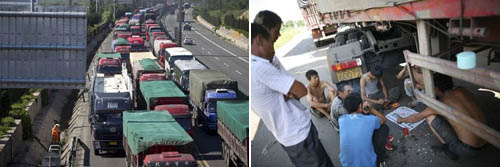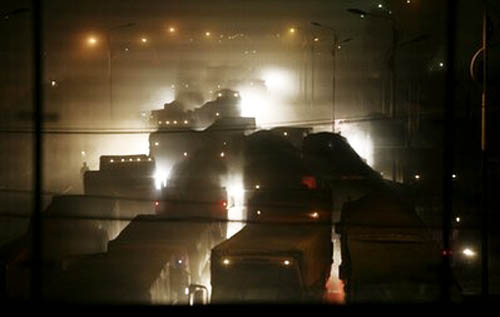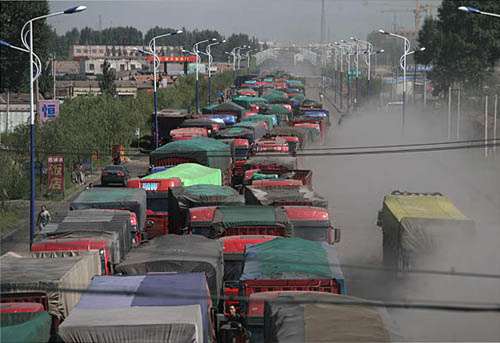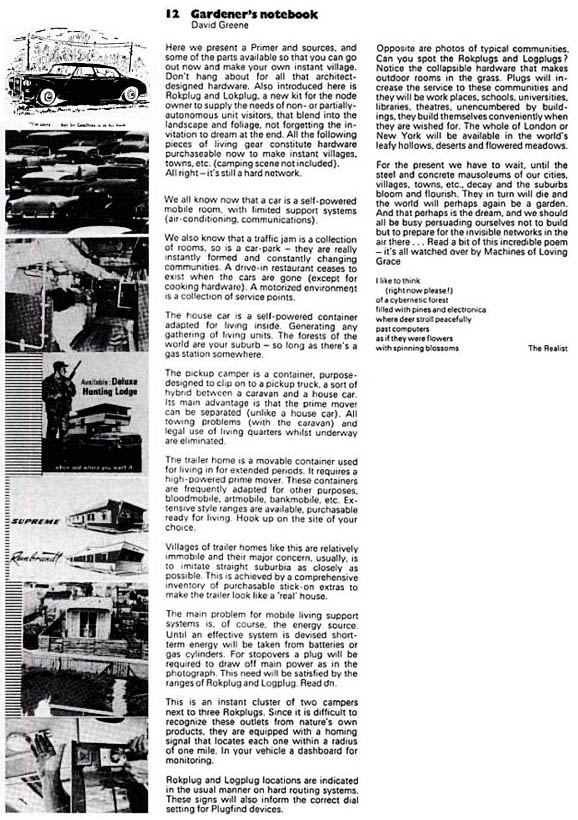 [Images: The micro-culture of the motorway; images courtesy Associated Press/Wall Street Journal].
[Images: The micro-culture of the motorway; images courtesy Associated Press/Wall Street Journal].
It was hard to miss the story last month that a 62-mile long traffic jam had formed in China, becoming a near-permanent feature of that nation’s roadway system. It lasted nine full days, in a state of almost perfect gridlock. NPR reported that drivers simply turned off their cars and slept for 8 hours at a time.
A temporary micro-culture of the motorway soon emerged: “Villagers along Highway 110 took advantage of the jam,” the Wall Street Journal reported, “selling drivers packets of instant noodles from roadside stands and, when traffic was at a standstill, moving between trucks and cars to hawk their wares. Truck drivers, when they weren’t complaining about the vendors overcharging for the food, kept busy playing card games.”
 [Images: The traffic jam as scene from Dante; images courtesy Associated Press/Wall Street Journal].
[Images: The traffic jam as scene from Dante; images courtesy Associated Press/Wall Street Journal].
But what if another such traffic jam were to form again? Where role might there be for architecture? Clip-on awnings, zip-up tent walls, velcro-connected halls and corridors spanning car-to-car and truck door to truck door, even crawlable tunnels for kids, with mobile parks on flatbed trucks, whole canopies held down by duct tape, antennas repurposed as anchors for tarps and makeshift roofs. Outdoor cinemas are formed. Social cliques develop.
The spatial infrastructure of the permanent traffic jam kicks in: guerrilla, unfoldable, pack-into-a-backpack-able, made from lightweight materials—ripstop fabrics and military-grade rope—a city takes shape on the highway, with every car, bus, truck, and motorcycle a luxury room or repurposed piece of home furniture.
 [Image: Courtesy of Newscom and the Christian Science Monitor].
[Image: Courtesy of Newscom and the Christian Science Monitor].
Lock this in place a few years and give it a postcode. Children are born there. Like Dan Hill‘s quip that “There are 500000 people airborne at any one time. A drifting airborne city, the size of Helsinki, a few meters tall, threaded around [the] globe,” this city-on-the-road would be named, memorialized, revisited. New highways would simply thread around it, abandoning the vehicles to their stationary fate as their tires drain of air and engines stall forever.
Generations later, the fact that, down in the mud and dust beneath your metropolis, you can find abandoned frames and chassis from the city’s founding traffic jam, will be impossible to believe—a run-of-the-mill urban legend. Archaeologists will argue over the best sites to excavate to find truck doors and ancient oil spills down there in the formerly mobile foundations of the city.
Even David Greene of Archigram once wrote that “a traffic jam is a collection of rooms.”
 [Image: From Archigram].
[Image: From Archigram].
“We also know that a traffic jam is a collection of rooms,” Greene wrote in a short text called “Gardener’s notebook,” and “so is a car park—they are really instantly formed and constantly changing communities. A drive-in restaurant ceases to exist when the cars are gone (except for cooking hardware). A motorized environment is a collection of service points.”
On the level of architecture, then, what could we do to prepare for the impending return of the near-permanent Chinese traffic jam? What prosthetic walls, floors, ceilings, and corridors—what new families of clip-on architectural forms—could we explore?
Traffic Walls™—an instant city brought to you by North Face and the GA Tech School of Architecture. Easily deployed. Houses up to 10,000 people. Machine-washable.